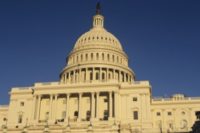GOP or Democrat: Does it really affect OSHA?

There is the rhetoric, and then the reality. Since 2008, with the U.S. economy unable to pull itself out of the muck of the deepest and ugliest recession since the Great Depression, Republicans have pounced on regulations of almost any sort as jobs killers. And OSHA boss David Michaels has spent the past three years on the defensive, claiming over and over that “OSHA doesn’t kill jobs; it helps prevent jobs from killing workers.”
The supposed bottom line: Democrats regulate and Republicans deregulate.
The reality: Except for Ronald Reagan and President Obama, Republican and Democratic administrations have issued new regulations at the exact same rate, according to Susan Dudley, director of the George Washington University Regulatory Studies Center, writing in a recent article in Politico.
The elusive truth
Campaign exhortations support what we think we know about the difference of how OSHA fares under Republicans and Democrats. The truth, always elusive in Washington, tells a different tale. According to government data going back the past 30 years, Presidents George H.W. Bush, Clinton, and George W. Bush each published an average of 45 major rules a year for all of the federal government.
Writes Dudley in Politico: Regulatory actions hinge to a great degree on statutory law and previous legal decisions, leaving presidents with less influence over regs than they might have thought.
We’ve surely seen these constraints confine OSHA standards-setting. Between 2002 and 2008, during the two terms of President George W. Bush, the agency issued eight final standards. Most if not all were non-controversial “niche” standards covering things like exit routes, commercial diving, and vertical tandem lifts.
In President Obama’s years in office, three final OSHA rules have been issued: covering cranes and derricks, conditions in shipyards, and the biggest impact standard by far, the Globally Harmonized System for hazard communication labels and safety data sheets. But the GHS is not some Democratic invention; its origins go back to the United Nations early this century.
Falling behind
For supposedly aggressive and zealous regulators, the Democrats have been slow on the draw. The White House has yet to publish its Spring 2012 agenda of upcoming regulatory actions. It’s now almost six months overdue. The last word out of the administration on its regulatory plans came on January 20, 2012, when the Fall 2011 regulatory agenda was issued.
And that Fall 2011 reg blueprint, in terms of what is in the works at OSHA, is far from anything that should intimidate employers. Seven rules are listed in the nebulous “prerule” category, including tough to hammer out regs such as the injury and illness prevention program (I2P2), bloodborne pathogens and infectious diseases. “Prerule” is a sort of limbo land where OSHA’s intentions for a regulation are spelled out years if not decades before implementation.
Four regs on the Fall 2011 agenda fall into the “long-term action” category. This is another way station or spur off the main regulatory rail tract, another way to park some of OSHA’s most controversial standards. Hot to handle topics in the latest long-term listing include exposure to beryllium, combustible dust, and specifically recording musculoskeletal disorders (MSDs) in OSHA recordkeeping logs.
So for all the bluster about a new sheriff in town and OSHA being back on the beat — the tough talk from Labor Secretary Hilda Solis and OSHA officials in 2009 when the Obama administration was busy laying down markers for the next four years — has OSHA been more influential, more visible on your radar screen as an EHS professional? (Aside from the new GHS requirements.)
Rulemaking irrelevance
OSHA’s slide into rulemaking irrelevance has been long in the making, encompassing both Democratic and Republican administrations. It was the Clinton administration that used OSHA as the poster child for a more user-friendly, “reinvented” regulator. Elaine Chao, the first Labor Secretary in George W. Bush’s cabinet and wife of staunch anti-regulator Sen. Mitch McConnell (R-KY) followed the reinvention campaign by telling OSHA chief nominee John Henshaw to forget about issuing any new regs, according to Washington sources.
Another area where Republicans and Democrats are on the same page regarding OSHA is in building its technology and outreach capabilities. David Michaels in a recent speech proudly touted these statistics: 200 million visitors to OSHA’s website in FY 2011; 200,000 responses to OSHA 1-800 calls for help; 33,000 e-mail requests for assistance answered; 5,300 outreach activities by regional and area offices, 27,000 small businesses helped through consultation.
In the absence of standards-setting, this is how OSHA has remained relevant: its online and off-line consultation; enforcement of severe, repeat offender penalty violators (hard to argue with), and its National (enforcement) Emphasis Programs, which draw attention and apply pressure to hot spots where the agency is unable to make a difference through new standards — such as combustible dust exposures, silica exposures, nursing and residential care facilities and flavoring chemicals/diacetyl.
What if…
If Obama is re-elected, it’s possible that OSHA will go for broke and push hard to publish regs on I2P2, beryllium, combustible dust, silica and confined spaces in construction. After all, there are no political consequences to be paid; Obama rides off into a Hawaiian sunset or back to Chicago or whatever in 2016. But this would be quite a stretch — little OSHA just doesn’t have the bucks to push out all these contentious rules — even if issuing “midnight regulations” at the very end of an administration’s tenure is a tradition
at the agency.
If Mitt Romney gets the nod, you will see a difference at the top of OSHA. Forget about academics such as Dr. Michaels and laborites such as Jordan Barab, Michaels’ chief lieutenant, and Deb Berkowitz, the current chief of staff. Republicans favor corporate types running the agency, such as Jerry Scannell from Johnson and Johnson, John Pendergast from 3M, and John Henshaw from Monsanto. The Voluntary Protection Program for elite company safety programs, which soared in membership during Henshaw’s time at OSHA, will likely be much more front and center than it has been in the Obama administration.
But it was also during Republican years in the White House that OSHA issued some of its most profound standards — the hazard communication rule and the hearing conservation amendment during the Reagan years; and the confined space standard during George H.W. Bush’s term. Plus, H.W. had an aggressive, pro-safety Labor Secretary in Elizabeth Dole who backed Jerry Scannell’s ambitious and ultimately failed attempts to regulate seat belt usage in vehicles and smoking in the workplace.
So is there really much to choose from between Romney and Obama on November 6 in terms of OSHA’s future? History says Republicans and Democrats are not far apart, especially when it comes to setting standards. And consider this: you don’t have a vote in what can be the most crucial determinant in OSHA’s direction, the naming of the Secretary of Labor. That’s who sets the boundaries, narrow or wide, and the job description of the OSHA chief.
Looking for a reprint of this article?
From high-res PDFs to custom plaques, order your copy today!








